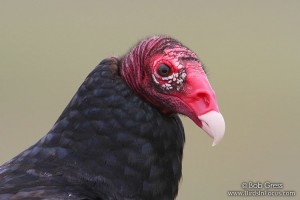Turkey Vulture
Turkey Vulture (Cathartes aura)
Photo Credit: Bob Gress <www.BirdsinFocus.com>
Turkey Vultures are scavengers that feed almost exclusively on carrion. Their outstanding sense of smell allows them to detect gases generated by decay processes in dead animals. Since many pathogens such as anthrax and hog cholera cannot survive passage through their digestive tracts, Turkey vultures limit the spread of carrion-borne diseases. In parts of the world where vultures are declining in number, rats and feral dogs are increasing.
Their “V”-shaped wing configuration makes Turkey vultures easy to spot as they easily soar on thermal air currents, needing to flap their wings only occasionally. The plumage of males and females are nearly identical. Body feathers are dark brown to black. In flight, white to grey feathers on the underside of their wings become apparent. Their heads are red and nearly free of feathers. They have a short curved, ivory colored beak. Turkey vultures are found in many parts of Kansas and are protected by the Migratory Bird Treaty Act of 1918.

